Rick Beato – The Real Reason Why Music Is Getting Worse
An evening pause: His conclusions have implications far beyond music itself and on the entire worsening of our culture.
Hat tip Chris McLaughlin.
An evening pause: His conclusions have implications far beyond music itself and on the entire worsening of our culture.
Hat tip Chris McLaughlin.
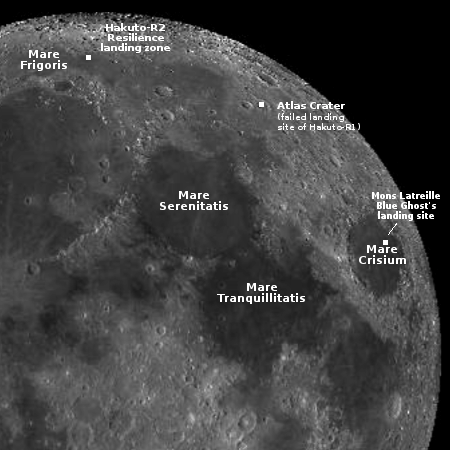
According to a media update from NASA yesterday, Firefly’s Blue Ghost lunar lander now targeting mid-January launch window for its unmanned mission to the Moon.
A six-day launch window opens no earlier than mid-January 2025 for the first Firefly Aerospace launch to the lunar surface.
The Blue Ghost flight, carrying 10 NASA science and technology instruments, will launch on a SpaceX Falcon 9 rocket from Launch Complex 39A at the agency’s Kennedy Space Center in Florida. Media prelaunch and launch activities will take place at NASA Kennedy.
The first quarter of 2025 will be a busy time for unmanned missions to the Moon. In addition to Firefly’s mission, the American startup Intuitive Machines also hopes to launch its Athena lander to the Moon’s south pole in February. Though it will launch after Blue Ghost, it will get to the Moon first, as it is taking a more direct week-long route compared to Blue Ghost’s 45-day journey. In addition, the Japanese company Ispace is targeting its own January launch for its Resilience lander.
If all three lift off as planned, there will be three landers heading for the Moon in early 2025.
NASA yesterday announced that it has awarded the launch contract for sending its Dragonfly mission to Titan to SpaceX’s Falcon Heavy rocket.
The firm-fixed-price contract has a value of approximately $256.6 million, which includes launch services and other mission related costs. The Dragonfly mission currently has a targeted launch period from July 5, 2028, to July 25, 2028, on a SpaceX Falcon Heavy rocket from Launch Complex 39A at NASA’s Kennedy Space Center in Florida.
Dragonfly is a truly cutting edge mission. Though we have relatively limited information about Titan’s atmosphere and the environment on its surface, it will attempt to fly there like a helicopter, landing and taking off multiple times.
And though there are certainly additional costs required for such a mission, that quarter-billion dollar contract price probably triples what it normally costs SpaceX for a Falcon Heavy mission. Even if it requires the expending of all three first stages, the company is almost certainly getting a big windfall from this deal.
Italy has now decided to re-open its long unused San Marco spaceport facility off the coast of Kenya, resuming launches from its off-shore launch platform.
During its active life beginning in 1967 a total of eight launches occurred from this site, with the last flight occurring in 1988.
In late 2023, the Minister of Enterprise and Made in Italy, Adolfo Urso, first proposed reopening the facility for rocket launches. While unsubstantiated by other sources, local publication MalindiKenya.net reported at the time that the move would be used to create an “ideal launch base for the Italian Vega launcher, thus avoiding paying France for the use of the French Guiana base.”
In October 2024, during a presentation just before the 75th International Astronautical Congress kicked off, Minister Urso explained that the country had decided to move ahead with its plans to once again launch rockets from the Luigi Broglio Space Center.
The present plans will have the site managed by the Kenya Space Agency, established in 2017, with Italy providing the rockets and satellites, all of which are expected to be smallsats. It appears that the rocket company Avio, which builds the Vega-C rocket, might be aiming to use this site as an commercial launchpad, thus allowing it to bypass the French-run French Guiana spaceport. Located close to the equator and on the coast, this site would offer satellite companies a very wide range of orbits.
The past twelve hours was quite busy at spaceports worldwide, with two American companies completing three different launches from three different spaceports, while China added one of its own.
First China launched two radar-mapping satellites, its Long March 2C rocket lifting off from its Jiuquan spaceport in northwest China. No word on where its lower stages, that use very toxic hypergolic fuels, crashed inside China. Though this launch was first, it actually took place in the early morning of November 25th, in China.
Next, Rocket Lab completed two launches, though one was not an orbital flight. First it completed its second of four planned launches of its HASTE suborbital version of its Electron rocket, lifting off from Wallops Island in Virgina. HASTE had been quickly improvised by the company when it realized there was a real market for hypersonic suborbital testing, and Electron could be refitted for that purpose. This launch actually occurred prior to the Chinese launch.
Then Rocket Lab launched five more satellites for the satellite company Kineis, the third of five, its Electron rocket lifting off from one of its two launchpads in New Zealand.
Finally, SpaceX in the early morning of November 25th launched 23 Starlink satellites, its Falcon 9 rocket lifting off from Cape Canaveral in Florida. The first stage completed its thirteenth flight, landing on a drone ship in the Atlantic.
The leaders in the 2024 launch race:
121 SpaceX
54 China
14 Russia
13 Rocket Lab
American private enterprise now leads the rest of the world combined in successful launches 140 to 81, while SpaceX by itself leads the entire world, including American companies, 121 to 100.
SpaceX tonight successfully launched another 20 Starlink satellites, 13 of which had direct-to-cell capabilities, the Falcon 9 rocket lifting off from Vandenberg in California. (Note that the live stream starts late, missing the launch itself).
The first stage completed its 15th flight, landing on a drone ship in the Pacific.
The leaders in the 2024 launch race:
120 SpaceX
53 China
14 Russia
12 Rocket Lab
American private enterprise now leads the rest of the world combined in successful launches 138 to 80, while SpaceX by itself leads the entire world, including American companies, 120 to 98.
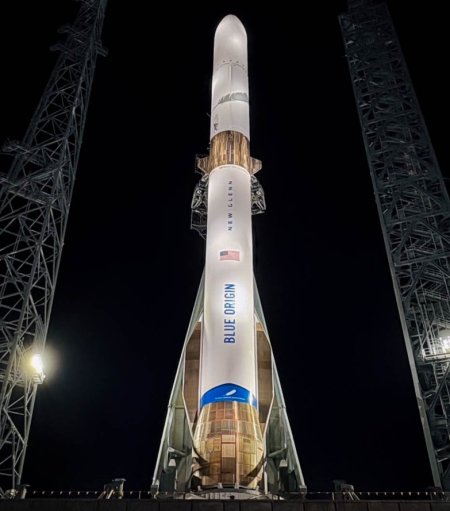
The first completely assembled New Glenn,
on the launchpad
Blue Origin’s first New Glenn rocket to be fully stacked and ready for launch was finally placed vertical on its Cape Canaveral launchpad late November 21, 2024.
For the first time, the company placed a fully integrated, flight-capable rocket on the launch pad Thursday evening. The company rolled the rocket out of the hangar at Launch Complex 36 (LC-36) earlier. A static fire test with the full 98-meter-tall (320 ft) rocket is forthcoming, though a specific date hasn’t been announced.
…The upcoming integrated static fire test would be the first time that Blue Origin fuels a full-assembled. flight-ready New Glenn rocket. It previously conducted a static fire test of its upper stage, which saw a 15-second burn of the two BE-3U engines.
The picture to the right was released by the company that night.
No launch date has been announced. The present payload for this launch is the company’s own Blue Ring orbital tug on a Pentagon-supported test flight. The original payload, two smallsat NASA Mars orbiters built by Rocket Lab, had to be pulled when Blue Origin’s generally leisurely approach meant that it was unable to get the rocket ready in time to meet the October launch window.
That leisurely approach to business will have to end if Blue Origin really wants to compete in today’s modern aerospace industry.
Capitalism in space: The lunar lander version of SpaceX’s Starship has won a contract from the startup Lunar Outpost to deliver its manned rover to the Moon.
The Colorado company announced Nov. 21 that it signed an agreement for SpaceX to use Starship to transport the company’s Lunar Outpost Eagle rover to the moon. The companies did not disclose a schedule for the launch or other terms of the deal.
This announcement is less a new deal for SpaceX and more an effort to convince NASA to award Lunar Outpost the full contract to build the rover. In April 2024 Lunar Outpost was one of three companies chosen by NASA to receive initial development grants to design their proposed manned lunar rovers. NASA expects to award the full contract, worth potentially up to $4.6 billion, to one of these three companies later this year, after seeing their preliminary designs. It wants to choose two, but at present says budget limitations make that impossible.
Both the Space Force and ULA have now admitted that the next two Vulcan launches, which both had hoped to launch before the end of this year, have now been delayed until 2025, and that Vulcan remains uncertified as yet by the military for its launches.
The United Launch Alliance’s Vulcan will not be able to conduct two planned national security missions on its launch manifest for this year after delays with certifying the heavy-lift rocket. The comments came hours after a Space Force official cast doubt that the missions could be completed before the end of 2024.
ULA launched its second certification flight in October, roughly a month behind schedule, following a first flight in January that was nearly four years behind schedule. The Space Force is still assessing data from the October launch in partnership with ULA.
The military had said if ULA completed two Vulcan successful launches it would approve Vulcan for these launches. Though the second launch got its payload to its correct orbit, during launch the nozzle on one of its strap-on solid-fueled boosters fell off. Though officials keep saying they expect certification anyway, that certification has not happened. It appears right now that the military won’t do so until the investigation into the problem is completed and a fix is installed.
At the moment the only rocket company that can launch large payloads for the Pentagon is SpaceX. Though that company has not gouged the military in bidding (though it it could) this is not a good situation. The military wants options and redundancy, not simply to save money, but to give it flexibility. It needs ULA and Blue Origin to finally deliver their rockets.
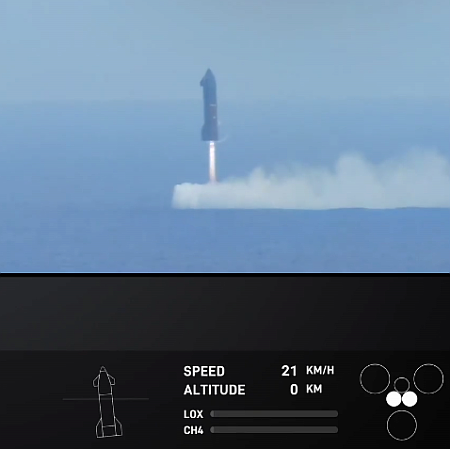
Starship splashing down vertically in the
Gulf of Mexico on November 19, 2024
Yesterday radio host Robert Pratt sent me a news story from a Texas newspaper, the Texas Tribune, which attempted quite surprisingly to capture fairly the local response to the most recent Starship/Superheavy test launch out of Boca Chica on November 19, 2024.
The reporter, Bernice Garcia, clearly made it a point to talk to a lot of people, especially those who came out to see the launch. As a result, she showed that in general, no matter what people felt about Donald Trump or Elon Musk, the local population was almost entirely in favor of SpaceX’s efforts there. For example:
Sanchez was slightly concerned about [the rocket’s sonic booms] but believed the benefits of jobs created by SpaceX was worth the risk. “They know what they’re doing,” Sanchez said.
But his favorable opinion of Musk’s company did not extend to Trump. A naturalized citizen who gained amnesty under the Reagan administration, Sanchez didn’t view Trump’s immigration policies as logistically sound. “If you throw those people out, who’s going to work?” Sanchez said. “You don’t see a white man laboring out in the sun. On the other hand, Mexicans, foreigners, people from other countries –– that’s why they come here, to work.”
While the story found locals with a whole range of opinions about Trump, both positive and negative, it only quoted one person who was hostile to SpaceX, and that quote and person tells us a great deal about the bankrupt nature of that opposition:
» Read more
On November 19, 2024 I noted that in awarding four new rocket startups development contracts worth a total of 44 million euros, the European Space Agency (ESA) had not given any of that grant money to its biggest and most established rocket company, ArianeGroup, which not only owns and builds the Ariane-6 rocket but also has a subsidiary called MaiaSpace that is developing its own smallsat partly reusable rocket, in direct competition with those four small startups.
The exclusion of ArianeGroup in that announcement suggested to me that ESA had decided ArianeGroup’s smalsat rocket subsidary could manage without any additional aid, since its owner is a well-financed big space contractor.
I was wrong. Today the ESA awarded ArianeGroup a much big pile of cash, totaling 230 million Euros, to further finance the development of a reusable demonstration rocket, dubbed Themis, that also uses ArianeGroup’s Prometheus rocket engine. The Themis hopper project has been under development since 2018 initially under the management of Arianespace, has seen many delays in that time, and is now three years behind schedule.
Because of these delays, ESA pulled it from Arianespace in 2022 and gave full control of the project to the builder, ArianeGroup. This new contract award appears to be cementing this new arrangement, and is in addition to previous awards for this project exceeding 224 million euros.
The award also apparently includes funds for ArianeGroup’s MaiaSpace smallsat rocket startup, though the exact amount has not been specified.
The bottom line is that ESA is still dumping lots of cash to its older big space companies. Despite its clear shift to promoting independent rocket startups instead of a single government-controlled commercial entity (Arianespace), it is still favoring the big space contractors like ArianeGroup it has used for decades under that old Soviet-style system.
It will be interesting to see how this unbalanced system plays out in the coming years. Europe might get a competitive rocket industry of many companies, but then it might not, considering its space agency is putting its thumb on the scale to favor the already-established players.
UPDATE: The original post below is incorrect. I misread Musk’s tweet, not realizing he was refering exclusively to Starship when he wrote “ship.” He and his company now routinely use “ship” to refer to Starship and “booster” for Superheavy.
The real story behind this tweet is that SpaceX is working to attempt a chopstick catch of both Superheavy and Starship on the eighth test flight, after the as-yet unscheduled seventh flight. This means the eighth flight of Starship will be a full orbital flight, will use its Raptor engines to do a de-orbit burn to bring it back to Boca Chica, and that the company expects to have two launchpad towers ready to make the two catches.
Won’t that be an exciting event?
Original incorrect post:
———————————–
According to a tweet by Elon Musk on November 19, 2024, SpaceX will not attempt a chopstick landing of Superheavy on the seventh test orbital launch of Starship/Superheavy.
We will do one more ocean landing of the ship. If that goes well, then SpaceX will attempt to catch the ship with the tower.
According to an update on the SpaceX website, the decision to abort the chopstick landing during this week’s sixth test flight was made because of issues at the launch tower:
Following a nominal ascent and stage separation, the booster successfully transitioned to its boostback burn to begin the return to launch site. During this phase, automated health checks of critical hardware on the launch and catch tower triggered an abort of the catch attempt. The booster then executed a pre-planned divert maneuver, performing a landing burn and soft splashdown in the Gulf of Mexico.
At this moment SpaceX has not provided any additional information on what those issues at the tower were, and might never do so since this is proprietary information. Nonetheless, it could be that more work is necessary to make sure the tower is healthy after launch, which is why they won’t attempt a chopstick landing next time.
As for when that seventh test flight will occur, we as yet have no word. The timing is going to depend on many factors, including the need for upgrades, the final flight plan decision, any changes then required to SpaceX’s FAA launch license, and finally the impact the new Trump administration will have on that red tape.
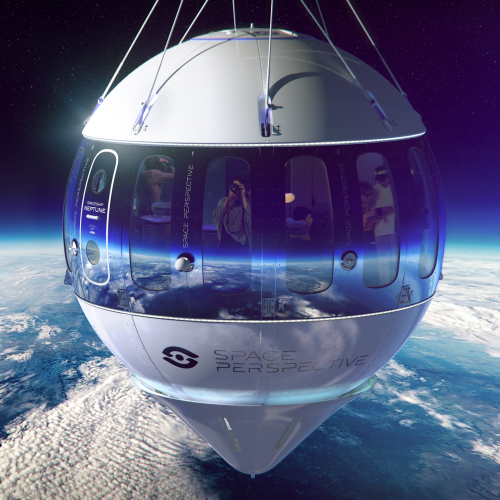
Space Perspective’s Neptune balloon capsule
The high altitude balloon company Space Perspective is presently in discussions with a number of Middle Eastern nations to find a location from which tourists can take tourist flights on its Neptune balloon capsule.
The Florida-based company is spending time in the Gulf to evaluate opportunities and expects to select a location in the first quarter of 2025, Michael Savage, its chief executive, told The National on Wednesday on the sidelines of the Skift Global Forum East in Dubai.
“We have interest from the UAE and entities from Abu Dhabi have come to visit mission control more than once. And we have interest from Qatar and from Saudi Arabia,” he said. “Our customer base likes to vacation in and visit this region, this has become a global hub for high-net worth vacationing … and because this is a luxury experience, it’s ideal for us to be as close as possible to that demographic.”
This the same approach that another American balloon company, World View, proposed in 2022. Since then however that company has not announced any updates of the tourist version of its high altitude balloons, which it has mostly been using to provide reconnaissance data for the Pentagon.
The new American company Inversion Space — which is developing an orbiting cargo capsule called Arc — has now raised $44 million in private investment capital.
The Los Angeles-based company announced Nov. 20 that it raised a Series A round led by Spark Capital and Adjacent, with participation from Lockheed Martin Ventures, Kindred Ventures and Y Combinator. The company has raised $54 million to date, with a $10 million seed round in 2021. It also won in September a Strategic Funding Increase (STRATFI) agreement with the Space Force’s SpaceWERX valued at $71 million, a combination of government and private funding to support work on reentry vehicles tailored for military customers.
Inversion will use the funds to further development of Arc, a reentry vehicle designed to provide what it called “precision delivery on-demand” from space to the Earth. The company is currently working on the design of Arc with a first flight planned for 2026.
The number of companies developing orbiting cargo capsules, either to provide supplies to the new space stations or to do manufacturing in orbit for return and sale on Earth, appears to be growing by leaps and bounds. First there was SpaceX’s Dragon, though the company has not yet flown any in-space manufacturing missions. Varda followed next, and has already flown and returned one capsule successfully. Sierra Nevada will follow next year with the first launch of its reusable Tenacity Dream Chaser mini-shuttle. Inversion will be the fourth.
In Europe there is The Exploration Company in France with its Nyx capsule, the German startup Atmos with its Phoenix capsule, and the Spanish startup PLD with its Lince capsule. There may be more.
All of these orbiting and returnable capsules have multiple profit opportunities, which explains why there has been a willingness of investors to provide them funds. They can either supply cargo to the four private stations presently under construction, or fly independent orbital missions where the capsule carries equipment to produce products of value that can only be manufactured in weightlessness.
Both Russia and the American company SpaceX successfully completed launches this morning. First, Russia sent a new Progress freighter on its way to ISS, its Soyuz-2 rocket lifting off from the Baikonur spaceport in Kazakhstan. The cargo ship is planned to dock with ISS in two days.
Next SpaceX put another 24 Starlink satellites into orbit, its Falcon 9 rocket lifting off from Cape Canaveral in Florida. The first stage completed its 20th flight, landing on a drone ship in the Atlantic.
The leaders in the 2024 launch race:
119 SpaceX
53 China
14 Russia
12 Rocket Lab
American private enterprise now leads the rest of the world combined in successful launches 137 to 80, while SpaceX by itself leads the entire world, including American companies, 119 to 98.
Capitalism in space: The French rocket startup Latitude yesterday announced that it has gotten a multi-launch contract from the German startup Atmos Space Cargo, which is developing its own returnable cargo capsule.
In a deal announced at Space Tech Expo Europe here Nov. 19, Atmos will buy a minimum of five launches a year of Latitude’s Zephyr rocket between 2028 and 2032. Terms of the deal were not disclosed.
Each launch will place a Phoenix spacecraft into very low Earth orbit, or VLEO. The spacecraft are designed to accommodate payloads for microgravity research in fields like pharmaceuticals and manufacturing, returning them to Earth.
Both companies have raised private investment capital, with Latitude raising $30 million and Atmos $1.4 million. Both are part of the sudden burst of new independent space companies that have emerged in Europe in only the last three years, even as many new American space startups have fallen by the wayside due to technical problems and government red tape.

The lion now is roaring, quite loudly.
Photo by Travis Jervey.
In part 1 of this series I described how it appears the American public today is no longer asleep and is instead very aggressively participating in the political and cultural debate in ways it has not in many decades, noting how this shift suggests we are experiencing a much more fundamental societal change than a mere shift in voting demographics.
In part 2 of this series I described how this fundamental shift has begun to express itself within the courts and politics in ways unheard of only five years ago. This expression illustrates the bottom-up nature of America, whereby the citizen is sovereign and our so-called leaders can only resist what those citizens want for only so long. And when those citizens become energized, as they now are, that resistance will evaporate with amazing speed.
In part 3 today I am going to take a more pessimistic view, based not on recent events but on the longer view I take naturally as a historian. I do this all the time in my histories. In Genesis: the Story of Apollo 8, in describing the political background behind that mission, I could not help noting how that mission changed America and its social goals significantly, for both good and ill. In Leaving Earth, I opened the book like so:
Societies change. Though humans have difficulty perceiving this fact during their lifetimes, the tide of change inexorably rolls forward, sometimes for better, sometimes for worse.
I then documented in detail the space efforts by both Russia and the United States in the decades after the Apollo landing and the politics behind those programs, with both providing a great window into how both societies changed in the second half of the 20th century. As I concluded, “They were like ships passing in the night.”
Similarly, the major cultural and political shift away from big government and the regulatory state that I think we are now experiencing in the United States is not going to change our country overnight. These things take time. People who firmly believe it is a good idea to “gender affirm” confused little kids by cutting off their breasts or castrating them are not going to change their minds easily. People who believe in big government — especially those who benefit from it — are not going to meekly allow that big government and those benefits to vanish without a fight.
The left’s long march through the institutions
» Read more
The FAA today announced that it has issued a revised draft environmental assessment [pdf] of SpaceX’s operations at Boca Chica in which the agency approves the company’s request to increase its Starship/Superheavy launch rate from 5 to 25 launches per year.
This does not mean that SpaceX can now launch that many times in 2025. The draft still has to go through more red tape, including public meetings and a comment period, then reviewed again by the FAA. In this announcement the FAA rescheduled those public meetings, as follows:
I strongly suggest that local businesses and citizens in the Brownsville area organize to show up en masse at these meetings to express their approval of SpaceX, because I can guarantee that the fringe anti-Musk activists groups SaveRGV, Sierra Club, the Friends of Wildlife Corridor, and the fake Indian Carrizo/Comecrudo Nation of Texas (which never existed in Texas) are organizing to be there to demand SpaceX be shut down.
Capitalism in space: NASA yesterday announced that is planning to award both SpaceX and Blue Origin contracts to use their manned lunar landers as cargo freighters to deliver supplies to its planned lunar base.
NASA expects to assign demonstration missions to current human landing system providers, SpaceX and Blue Origin, to mature designs of their large cargo landers following successful design certification reviews. The assignment of these missions builds on the 2023 request by NASA for the two companies to develop cargo versions of their crewed human landing systems, now in development for Artemis III, Artemis IV, and Artemis V.
…NASA plans for at least two delivery missions with large cargo. The agency intends for SpaceX’s Starship cargo lander to deliver a pressurized rover, currently in development by JAXA (Japan Aerospace Exploration Agency), to the lunar surface no earlier than fiscal year 2032 in support of Artemis VII and later missions. The agency expects Blue Origin to deliver a lunar surface habitat no earlier than fiscal year 2033.
The contracts however have not been issued. This is merely an announcement of NASA’s intent to do so, which suggests to me that NASA management has already recognized that the entire Artemis program is facing a major restructuring and wants to indicate it will support such a change. That does not mean these contracts won’t be issued — both rely on the privately owned rockets of both companies — but that NASA now realizes that its manned program — which now relies on SLS/Orion — will likely to be changed significantly, likely by the elimination of SLS/Orion and its replacement by private rockets and private manned spacecraft.
Because of this looming restructuring, NASA management probably intended this press announcement — which really announces little that is new — as a signal of its support for such a change, because the announcement focuses on these private companies rather than NASA’s government-built rocket.
If anyone thinks the anti-Musk activists groups that have been using lawfare to try to shut down SpaceX’s Boca Chica facility have any local support, this story should put a quash on that. According to the airport director for the Brownsville-South Padre Island Airport, all flights sold out leading up to the sixth test flight of Starship/Superheavy.
Airport director Angel Ramos told Channel 5 News he’s noticed traffic increases whenever SpaceX does a flight test. “People are excited,” Ramos said. “They’re wearing SpaceX hats and SpaceX shirts [when they come] in to the airport.”
Ramos said flights were sold out between Sunday and Tuesday, and 700 people have been arriving daily at the airport since Sunday. “There is no launch that happens that we don’t see lots of people coming in and out of the airport, and now that they continue to be more frequent and more successful, people are paying more interest and actually coming days before,” Ramos said.
The story was reported by the local ABC television affiliate, and reflects the very positive impact SpaceX is having on the local community that is recognized quite clearly by everyone who lives there. The Brownsville area had been economically depressed for decades. Now the economy is booming, all because of SpaceX.
The public wants SpaceX there. The nay-sayers represent practically no one. That many local news organizations not only don’t report these facts when they cover the lawfare of these activists but instead often frame their stories as if the opposition is general throughout the region is shameful and an indication of the bankrupt nature of these press outlets.
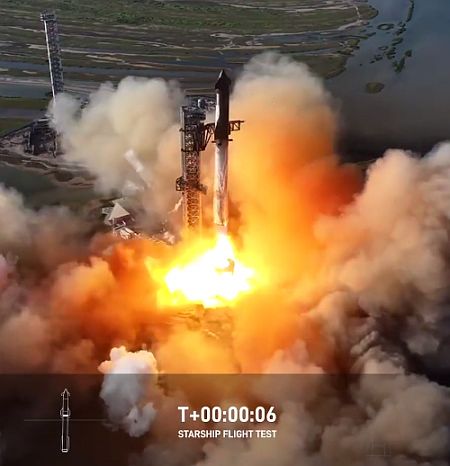
SpaceX today successfully completed the sixth orbital test flight of its Starship/Superheavy heavy lift rocket, only forty days after its previous test flight, the shortest turn-around so far, mainly because the FAA imposed no red tape to hold SpaceX back.
Before describing details of the flight, it is essential to note that this giant rocket, bigger than the Saturn-5 that sent Apollo astronauts to the Moon and intended to be completely reusable and being designed to be able to relaunch in mere hours, has been conceived, designed, built, and tested entirely by a private company and free American citizens, funded almost entirely by private investment capital hoping to make a profit from the rocket. The government and NASA has played almost no part, except possibly using its regulatory power improperly to slow development down by a year or two.
Even more important its development has cost a tiny amount compared to similar government programs, and has been accomplished in less than a third of the time.
Thus this rocket is a perfect example of freedom in action. Get the government out of the way and allow humans the freedom to follow their dreams, and they will do astonishing things.
As for the flight, Superheavy worked perfectly in getting Starship off the launchpad and on its way into orbit. However, engineers canceled a second tower catch attempt and instead diverted Superheavy to complete a soft splashdown just off the coast in the Gulf of Mexico. The booster touched down on the water quite softly, and then fell over into the water. Expect SpaceX to quickly do salvage operations to recover it.
Starship reached its orbit as planned, carrying for the first time a payload, a single plastic banana suspended by cords in the center of the Pez deployment payload bay where SpaceX hopes to soon begin deploying Starlink satellites. Though somewhat silly, the banana is being used by SpaceX and the FAA to certify future payload operations.
About 38 minutes into the flight engineers did the first re-light of one Raptor-2 engine while in orbit, the burn lasting about three-four seconds. This burn demonstrated that Starship is capable of doing a de-orbit burn so that in a future flight it can be launched into a full orbit and use the engines to bring it back to a precise location on Earth, including possibly a return to the launch tower for its own chopstick catch.

Starship splashing down vertically
During re-entry the flight plan called for pushing Starship beyond its technical margins in order to learn exactly what those limits were. Even so, it appeared that — unlike the previous flights — there was very little evidence of damage to the flaps from the heat of re-entry. One flap appeared to have damage at one pointed end, and even that burn-through appeared far less than the previous flights.
During final descent and moving slower than the speed of sound they pointed the ship nose down in order to stress the flaps the most. Even so, the ship performed as planned, and splashed down softly and vertically in the Indian Ocean.
Though the flight plan for this Starship flight as well as the previous flights was purposely designed to bring it back to Earth before it completes an orbit, this was still essentially a successful orbital launch, and thus I am including it in my launch totals. The leaders in the 2024 launch race:
118 SpaceX
53 China
13 Russia
12 Rocket Lab
American private enterprise now leads the rest of the world combined in successful launches 136 to 79, while SpaceX by itself leads the entire world, including American companies, 118 to 97.

The lion now is roaring, quite loudly.
Photo by Travis Jervey.
In the first part yesterday of this three part essay, I described how Americans are no longer the disinterested public that we have seen for more than a half century. No longer is the left the only group with passion. Ordinary Americans are now paying attention, and appear aggressively unwilling to allow leftist bad policy and slanderous blacklisting go unchallenged. The public might not be partisan Republicans or conservatives, but it is nonetheless finally aware and outraged by the leftist agenda that has dominated government policy for the past decade, including policies that encouraged the mutilation and castration of children, allowed the queer agenda in schools, promoted anti-Semitism and bigotry throughout the workforce, and fueled an out-of-control federal government that only serves itself even as it squashes the freedoms of ordinary people.
In today’s second part, I wish to dig deeper, because the public’s willing outrage has already caused unexpected major attitude changes in places where such changes have been impossible for decades.
Let us begin with a somewhat complex court decision that I reported on last week. In this court decision, a two-judge panel went beyond the specifics of the lawsuit before it to rule instead on the basic legal authority of the White House Council on Environmental Quality (CEQ), concluding that its decades-long requirement that all government agencies obey its environmental recommendations in writing regulations was illegal, that CEQ simply did not have the statutory authority to do this.
As I said, the case itself is very complex. It is not even clear this ruling will stand up, since in the end the CEQ’s recommendations essentially reflect those of the President, whose authority to determine how the agencies under him create regulations based on Congressional law is legal and quite final.
The point however is not whether this decision will stand up. The point is that the judges were quite willing to rule on the legal authority of a government entity, and rule against its authority, essentially invalidating its power.
» Read more
A federal judge has now ruled that the $39 billion lawsuit by the satellite company Ligado against the federal government can move forward.
In October 2023, Ligado sued the government for $39 billion over claims that officials at the Departments of Defense and Commerce took “unlawful actions” to, in effect, improperly seize without compensation the firm’s L-band spectrum. In January, the government had asked a judge to dismiss the suit. Today Judge Edward J. Damich of the US Federal Claims Court ruled in part in favor of Ligado and in part for the government over aspects of the case, but ultimately said the case “may proceed.”
Essentially, after the FCC had awarded this spectrum to Ligado, the feds stepped in to take it away for its own use. The company argued that once it was given that spectrum to use for its satellites it was essentially its property, and that the seizure without due compensation was an illegal taking under the Fifth Amendment to the Constitution. This court decision allows this lawsuit to proceed.
The reason these federal agencies seized the spectrum this that they believe Ligado’s satellite constellation would interfere with GPS, something the FCC disputed in awarding the spectrum. Whether the company will win in court remains unclear.
Capitalism in space: The European Space Agency (ESA) this week awarded four European rocket startups — HyImpulse, Isar Aerospace, Rocket Factory Augsburg, and Orbex — new contact extensions worth €44.2 million total to continue the development of their commercial rockets.
According to ESA, the €44.2 million in funding awarded through the Boost! contract extensions is aimed at alleviating the pressure in the months before an inaugural flight when costs are high and the potential to generate revenue is limited.
…While the ESA press release did not disclose the specific amounts awarded to each company, announcements from the companies have revealed that Orbex will receive €5.6 million, Isar Aerospace €15 million, and both Rocket Factory Augsburg and HyImpulse €11.8 million each.
The first three companies are German-based, while Orbex is based in the United Kingdom. All four have received ESA grants under this program previously. None have yet actually attempted an orbital launch, but all four have been getting close, though all also face challenges. For example, Orbex, which had said it was ready to launch its Prime rocket in 2022, has been waiting for a launch license from Great Britain’s Civil Aviation Administration (CAA) for almost three years, to no avail. Rocket Factory meanwhile had hoped to launch its RFA-1 rocket this year, but could not after it was destroyed during a static fire dress rehearsal countdown in August.
Isar meanwhile has begun static fire tests of its Spectrum rocket at the Andoya spaceport in Norway. No launch date has been set. Hyimpulse in turn has flown a suborbital test flight from the Southern Launch spaceport on the south coast of Australia, but development of an orbital rocket seems farther behind its competitors.
This ESA contract award is also revealing in who did not get contracts. The large big space company ArianeGroup, which owns the Ariane-6 rocket, also has its own smallsat rocket startup, Maiaspace, that is attempting to compete with these other rocket startups, and had previously gotten ESA development contracts. That it got no contract extension under this program suggests ESA has decided it can manage without this aid, considering its owner is a well-financed big space contractor.
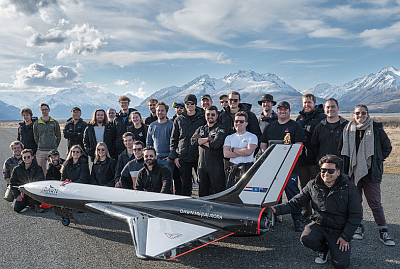
The crew and Mk-II Aurora
On November 12, 2024, the startup Dawn Aerospace for the first time flew its small-scale rocket-powered Mk-II Aurora unmanned airplane at speeds exceeding the speed of sound, becoming the first commercial airplane since the Concorde to break the sound barrier.
The company, operating as Dawn Hypersonics, achieved the milestone on 12 November 2024, with the Aurora surpassing the speed of sound for the first time, reaching Mach 1.1 and climbing to an altitude of 82,500 feet. This is over twice as high as commercial aircraft and marks the first time a civil aircraft has flown supersonic since Concorde. This achievement signifies a major step toward operational hypersonic travel and daily space access, establishing rocket-powered aircraft as a new class of ultra-high-performance vehicles.
The flight, conducted from New Zealand’s Glentanner Aerodrome near the base of Aoraki Mt Cook, exceeded its test target speeds and altitude of Mach 1.05 and 75,000 feet. The Aurora also set a global record, becoming the fastest aircraft to climb from ground level to 20 km (66,000 feet), completing the ascent in just 118.6 seconds. This beats the previous record, held by a highly modified F-15 ‘Streak Eagle’ in the 1970s, by 4.2 seconds.
It appears the company’s goals have changed and become less ambitious, at least for the moment. According to the company’s press materials now, the goal now is to sell Mk-II (and bigger versions) for suborbital hypersonic research, both for the military and private sector. Back in 2021 however the company described Mk-II as merely a preliminary test vehicle leading to the construction of a larger fullscale two-stage-to-orbit version that would take off and land on a runway and could be used to launch satellites to orbit.
In a sense, nothing might have really changed, other than the company realizing that it should try to make money on the Mk-II now, even as it flies and tests it in preparation for eventually building the larger orbital version. If Dawn begins to win contracts using this prototype, it will then have the resources (as well as the ability to raise more investment capital) to advance to larger more powerful version.

Have Americans finally awakened?
In my long life there have been a number of times post-election when pundits nationwide have claimed that the results signaled a major cultural transition. This claim was made in 1980 when Ronald Reagan was elected president. It was made again in 1994 when voters gave the Republicans their first majority in the House of Representatives in about four decades. A similar claim was made in 2016, when Trump was elected for the first time.
In every single one of these cases the claim was false. There was no major cultural transition. Republicans might have won control, but the American public and its political class still largely leaned leftward. There was almost no change politically. Despite for example Bill Clinton’s announcement that “The era of big government is over” after the 1994 election, the federal government continued to grow in size and power, and to do so with ever increasing speed.
Even more significant, in every single case, the American people went back to sleep after the election. They considered the election their statement of what must be done, and assumed naively that the new elected officials would obey that statement. No matter how much conservatives attempted to make the public aware that the government remained out of control and was further beginning to institute leftist policies far outside what anyone in America wanted, those attempts fell on deaf ears.
The American people were essentially not interested. The only political movement that moved with any passion was that of the left, and it took advantage of this passion to successfully to get its policies imposed.
It seems however that the 2024 election signals a real cultural transition, far deeper and more significant than the mere shift of voting patterns to the right that most pundits are noting by all demographic groups.
No, what is happening is a shift in passion. The American public has awakened in a way I have never seen. I give you this news report as a clear sign, as the events it describes occurred last week, after the November election, when Americans in the past would gone back into slumber and stop paying attention. Watch and be amazed, not just by the outrage by hundreds of ordinary citizens, but by the fact that this outrage was reported correctly and sympathetically by a television news report.
» Read more
SpaceX successfully completed two launches today, one from each coast.
First in the early morning the company sent 20 Starlink satellites into orbit, its Falcon 9 rocket lifting off from Vandenberg in California. The first stage completed its 20th flight, landing on a drone ship in the Pacific. Of the 20 satellites, 13 were configured for direct-to-cell service.
Next, SpaceX launched GSAT-20, a geosynchronous communications satellite for India’s space agency ISRO, which hired SpaceX because the satellite was too heavy for its own rockets. The Falcon 9 rocket lifted off from Cape Canaveral, with the first stage completing its 19th flight, successfully landing on a drone ship in the Atlantic. Of the two fairings, one completed its fifth flight while the second completed its first flight.
If we include the afternoon launch yesterday by SpaceX from Kennedy, the company did three launches from three locations in less than 24 hours. And it hopes to launch again tomorrow, this time flying Starship/Superheavy on its sixth test orbital flight, launching from the company’s launchpad in Boca Chica. I have embedded the live steam here.
The leaders in the 2024 launch race:
117 SpaceX
53 China
13 Russia
12 Rocket Lab
American private enterprise now leads the rest of the world combined in successful launches 135 to 79, while SpaceX by itself leads the entire world, including American companies, 117 to 97.
With these two launches today, the all-time global record for successful orbital launches in a year, set only last year at 213, has been broken, and there are still about five weeks left in 2024.
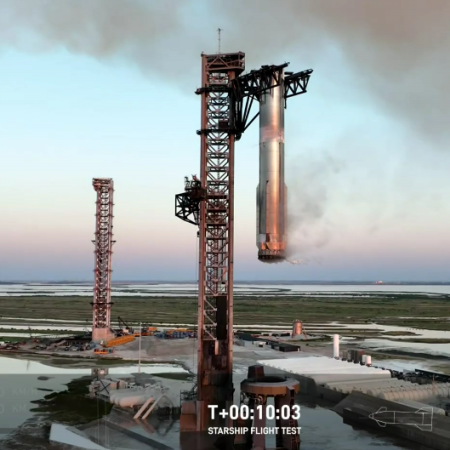
Superheavy after its October flight, safely captured at Boca Chica
Time for another Chicken Little report: A new study of the sound levels produced by SpaceX’s Superheavy booster during its fifth launch and landing at Boca Chica in October 2024 suggests that it produces more noise than predicted.
Overall … Gee et al. note that one of the most important conclusions from their data is the differences between Starship’s launch noise levels and those of SLS and Falcon 9. The team found that Starship produces significantly more noise at liftoff than both SLS and Falcon 9 in both A-weighted and Z-weighted (unweighted) noise metrics.
When compared to Falcon 9, the noise produced by a single Starship launch is equivalent to, at a minimum, 10 Falcon 9 launches. Despite SLS producing more than half of Starship’s overall thrust at liftoff, Starship is substantially louder than SLS. More specifically, one Starship launch is equivalent to that of four to six SLS launches regarding noise production. As has been hypothesized by numerous other studies into the noise produced by rockets, this significant difference in noise levels may be due to the configuration of first-stage engines on the rockets. For example, although the Saturn V produced less overall thrust than SLS, it produced two decibels more noise than SLS, which may be due to the clustered engine configuration on Saturn V’s first stage.
We’re all gonna die! Despite the doom-mongering of this study (which you can read here), the only issue noted by the paper from this noise was car alarms going off. And even here, the spread of the noise was asymmetrical, occurring in only one direction.
The concern about sonic booms has always been the annoyance they cause to residents near airports. In the case of Superheavy, it is very unlikely it will ever fly at a frequency to make its noise intolerable. More important, the nature of a spaceport versus an airport reduces the concern considerably, since a spaceport requires a much larger buffer area, and at both of SpaceX’s Starship launchsites in Florida and Texas almost everyone living close by works for the company or in the space business. They are not going to complain.
And while studying these noise issues is useful, we must not be naive about the real purpose of such studies. Underneath its high-minded science goals is a much more insidious one: finding a weapon for shutting down SpaceX. This concern of mine might be overstated, but remember, almost our entire academic community is rabidly leftist and made up of partisan Democrats. They hate Musk for his politics, and have been aggressively looking for ways to hurt him. This sound study is just another tool in that war.
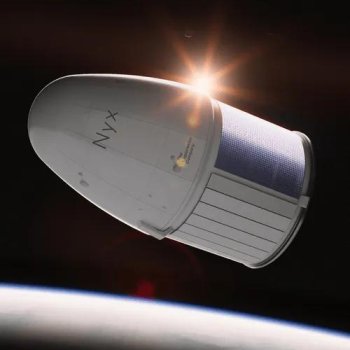
Artist rendition of the proposed Nyx cargo capsule,
taken from The Exploration Company’s website
The French cargo capsule startup The Exploration Company (TEC} announced today that it has raised an additional $160 million in private investment capital, bringing the total raised by the company to $230 million.
Venture capital firms Balderton Capital and Plural were the lead investors in the round which also included French government-backed investment vehicle French Tech Souveraineté and German government-backed fund DeepTech & Climate Fonds.
TEC’s core product is Nyx, a capsule that can be launched from rockets into space carrying passengers and cargo. Nyx is reusable so once it has dropped its payload, it can re-enter the Earth’s atmosphere and be used for the next mission.
The company hopes to do its initial test flight of Nyx in 2028. It flew a demonstrator prototype on the first Ariane-6 launch in July 2024, but was unable to test that prototype’s re-entry capabilities (its prime mission) because of a failure in Ariane-6’s upper stage. It hopes to fly a second demonstrator in 2025 on a Falcon 9.
At the moment company officials say they already signed $800 million in cargo contracts, 90% of which are with the commercial space station companies Axiom Space, Vast, and Starlab. The rest are government contracts.
SpaceX today successfully placed an Australian geosynchronous communications satellite into orbit, its Falcon 9 lifting off from the Kennedy Space Center in Florida.
The rocket’s two fairings completed their 10th and 20th flights respectively. The first stage completed its 16th flight, landing on a drone ship in the Atlantic. At posting the satellite had not yet been deployed.
The leaders in the 2024 launch race:
115 SpaceX
53 China
13 Russia
12 Rocket Lab
American private enterprise now leads the rest of the world combined in successful launches 133 to 79, while SpaceX by itself leads the entire world, including American companies, 115 to 97.